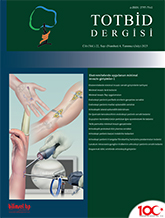
The distal radioulnar joint is stabilized by a combination of bony and soft tissue structures. The triangular fibrocartilage complex (TFCC) is a critical component for wrist stability. It consists of a complex ligamentous structure, a meniscal homologue, and an articular disk located between the ulnar carpus and the distal ulna. The stability of the distal radioulnar joint is significantly influenced by the dorsal and volar radioulnar ligaments. Ruptures of the triangular fibrocartilage complex are the most common cause of ulnar wrist pain and distal radioulnar joint instability. Chronic injury can lead to problems such as persistent pain, instability of the distal radioulnar joint, and arthritis. Injuries in patients with persistent pain or instability after conservative treatment, in patients with high physical demands, and athletes can be corrected by open and arthroscopic procedures. Existing surgical techniques include capsular sutures, suture anchors, and transosseous sutures. Arthroscopic treatment results in less morbidity and fewer complications, while also offering the patient the benefit of a quicker return to work.